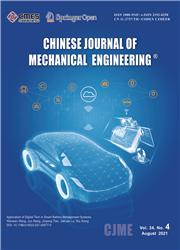基于视觉传感的机器人焊缝磨削在线校正系统
IF 4.5
2区 工程技术
Q1 Engineering
引用次数: 0
摘要
焊接磨削精度和表面一致性影响结构件的使用周期和动态性能。由于装配误差、热变形等原因,焊缝脱机磨削时,机器人的实际轨迹与理论轨迹不重合,造成工件表面质量差。针对这些问题,本研究开发了一种基于视觉感知的机器人焊缝磨削在线校正系统。该系统主要包括焊缝特征提取、磨削和机器人实时控制三个子系统。首先使用WorkVisual软件将研磨设备设置为机器人的变电站。通过I/O映射功能配置机器人与研磨设备通信的输入/输出(I/O)端口,使机器人能够控制研磨设备(启动、停止、速度控制)。随后,利用以太网KRL软件包编写数据交互结构,实现机器人与激光视觉系统的实时通信。为了修正工件弯曲变形引起的测量误差,采用多项式拟合算法建立焊缝区域母材表面轮廓模型,对测量数据进行补偿。修正后的焊缝宽度和高度误差分别降低了2.01%和9.3%。在线焊缝提取与校正实验验证了该系统校正功能的有效性,该系统可将磨削轨迹误差控制在0.2 mm以内。通过实际焊接磨削试验,验证了该系统的可靠性。粗糙度Ra可达0.504µm,平均残余高度在0.21 mm以内。在本研究中,我们开发了一种基于视觉感知的机器人焊接磨削在线校正系统,该系统具有良好的校正效果和较高的鲁棒性。本文章由计算机程序翻译,如有差异,请以英文原文为准。
Vision Sensing-Based Online Correction System for Robotic Weld Grinding
Abstract The service cycle and dynamic performance of structural parts are affected by the weld grinding accuracy and surface consistency. Because of reasons such as assembly errors and thermal deformation, the actual track of the robot does not coincide with the theoretical track when the weld is ground offline, resulting in poor workpiece surface quality. Considering these problems, in this study, a vision sensing-based online correction system for robotic weld grinding was developed. The system mainly included three subsystems: weld feature extraction, grinding, and robot real-time control. The grinding equipment was first set as a substation for the robot using the WorkVisual software. The input/output (I/O) ports for communication between the robot and the grinding equipment were configured via the I/O mapping function to enable the robot to control the grinding equipment (start, stop, and speed control). Subsequently, the Ethernet KRL software package was used to write the data interaction structure to realize real-time communication between the robot and the laser vision system. To correct the measurement error caused by the bending deformation of the workpiece, we established a surface profile model of the base material in the weld area using a polynomial fitting algorithm to compensate for the measurement data. The corrected extracted weld width and height errors were reduced by 2.01% and 9.3%, respectively. Online weld seam extraction and correction experiments verified the effectiveness of the system’s correction function, and the system could control the grinding trajectory error within 0.2 mm. The reliability of the system was verified through actual weld grinding experiments. The roughness, Ra, could reach 0.504 µm and the average residual height was within 0.21 mm. In this study, we developed a vision sensing-based online correction system for robotic weld grinding with a good correction effect and high robustness.
求助全文
通过发布文献求助,成功后即可免费获取论文全文。
去求助
来源期刊

Chinese Journal of Mechanical Engineering
ENGINEERING, MECHANICAL-
CiteScore
5.60
自引率
4.80%
发文量
3097
审稿时长
8 months
期刊介绍:
Chinese Journal of Mechanical Engineering (CJME) was launched in 1988. It is a peer-reviewed journal under the govern of China Association for Science and Technology (CAST) and sponsored by Chinese Mechanical Engineering Society (CMES).
The publishing scopes of CJME follow with:
Mechanism and Robotics, including but not limited to
-- Innovative Mechanism Design
-- Mechanical Transmission
-- Robot Structure Design and Control
-- Applications for Robotics (e.g., Industrial Robot, Medical Robot, Service Robot…)
-- Tri-Co Robotics
Intelligent Manufacturing Technology, including but not limited to
-- Innovative Industrial Design
-- Intelligent Machining Process
-- Artificial Intelligence
-- Micro- and Nano-manufacturing
-- Material Increasing Manufacturing
-- Intelligent Monitoring Technology
-- Machine Fault Diagnostics and Prognostics
Advanced Transportation Equipment, including but not limited to
-- New Energy Vehicle Technology
-- Unmanned Vehicle
-- Advanced Rail Transportation
-- Intelligent Transport System
Ocean Engineering Equipment, including but not limited to
--Equipment for Deep-sea Exploration
-- Autonomous Underwater Vehicle
Smart Material, including but not limited to
--Special Metal Functional Materials
--Advanced Composite Materials
--Material Forming Technology.
 求助内容:
求助内容: 应助结果提醒方式:
应助结果提醒方式:


